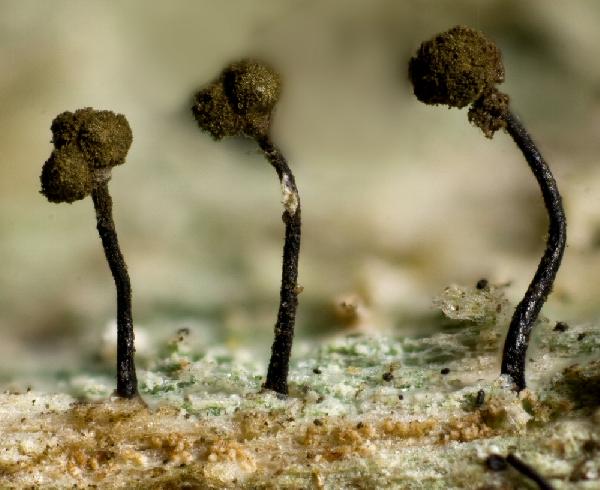Chaenotheca brunneola (Ach.) Müll. Arg.
Mém. Soc. Phys. Hist. Nat. Genève, 16: 360, 1862. Basionym: Calicium brunneolum Ach. - K. Vetensk.-Akad. Nya Handl.: 279, 1816.
Synonyms: Calicium flexipes Ach.; Calicium melanophaeum var. brunneolum (Ach.) Schaer.; Cyphelium brunneolum (Ach.) De Not.; Phacotium brunneolum (Ach.) Trevis.
Distribution: N - Frl (Puntillo & Puntillo 2009), Ven (Nascimbene 2008c, Puntillo & Puntillo 2009), TAA (Nascimbene & al. 2007b, Puntillo & Puntillo 2009), Lomb (Puntillo & Puntillo 2009), Piem (Puntillo & Puntillo 2009), VA (Puntillo & Puntillo 2018), Emil (Nascimbene & al. 2021), Lig (TSB 33590). C - Tosc (Puntillo & Puntillo 2009, Nascimbene & al. 2012, 2015), Umb (Ravera 1998, Ravera & al. 2006, Puntillo & Puntillo 2009), Laz (Puntillo & Puntillo 2009), Sar (Zedda 2002, 2002b, Puntillo & Puntillo 2009). S - Bas (Puntillo & al. 2012, Ravera & al. 2015b), Cal (Puntillo 1994, 1995, 1996, Lich. Graec. 269: Obermayer 2004, Puntillo & Puntillo 2009).
Description: Thallus crustose, endosubstratic or rarely thinly episubstratic and then finely granular, ecorticate. Apothecia stalked, pin-like, epruinose, shining black. Stalk slender, 0.5-1.5 mm high, sometimes branched and bearing 2-5 capitula, of periclinally arranged, medium brown hyphae: Capitula spherical, with a poorly developed excipulum continuous with the stalk tissue, epruinose but lower side sometimes appearing pruinose from short projecting hyphae. Mazaedium well-developed, brown; hypothecium medium brown, broadly obconical, with a strongly convex upper surface. Asci cylindrical, ellipsoid or irregular, formed in chains, dissolving early, with 1- or 2-seriate ascospores. Ascospores 1-celled, brown to pale brown, globose, 3.5-4.5 µm wide, the wall smooth or with irregular fissures. Photobiont chlorococcoid (Dictyochloropsis, the cells > 10 µm diam). Spot tests: thallus K-, C-, KC-, P- or P+ yellowish red, UV+ white. Chemistry: thallus with baeomycesic and squamatic acids.Note: on relatively soft-decomposed lignum of old coniferous stumps in humid woodlands, more rarely on wood of deciduous trees or even of Quercus ilex, very rarely corticolous. Old records from Sicily, not validated by Puntillo & Puntillo (2009) are excluded here. It is included in the Italian red list of epiphytic lichens as “Near-threatened” (Nascimbene & al. 2013c).
Growth form: Crustose
Substrata: lignum
Photobiont: green algae other than Trentepohlia
Reproductive strategy: mainly sexual
Commonnes-rarity: (info)
Alpine belt: absent
Subalpine belt: extremely rare
Oromediterranean belt: absent
Montane belt: very rare
Submediterranean belt: extremely rare
Padanian area: absent
Humid submediterranean belt: very rare
Humid mediterranean belt: extremely rare
Dry mediterranean belt: absent

Predictive model
Herbarium samples

Ulrich Kirschbaum CC BY-SA 4.0 - Source: https://www.thm.de/lse/ulrich-kirschbaum/flechtenbilder
Central Europe; Germany; Baden-Württemberg: Black Forest.


P.L. Nimis; Owner: Department of Life Sciences, University of Trieste
Herbarium: TSB (11866)
2001/12/05

Felix Schumm - CC BY-SA 4.0
[19627], Brazil, Rio de Janeiro, Serra da Mantiqueira, Itatiaia between Registro do Picú and Agulhas Negras, on wood within a mossy bank along the road, 2000 m, 22°20' S, 44°45' W. K. Kalb, 12.07.19797, det. A. Aptroot. KALB & APTROOT: LICHENES NEOTROPICI NR. 631.

Zahlbruckner A. 1926. Lichenes (Flechten). In: Engler A. (ed.): Die natürlichen Pflanzenfamilien. 2nd ed., vol 8, W. Engelmann, Leipzig, 270 pp.

Courtesy: Olivier et Danièle Gonnet - Source: https://www.afl-lichenologie.fr/Photos_AFL/Photos_AFL_C/Textes_C2/Chaenotheca_brunneola.htm
France, Forêt domaniale de Cardeilhac, alt. 480 m - Haute-Garonne - (31) - sur bois d’une partie écorcée de Castanea crenata dépérissant - leg., herb. et det. L. Ramond, conf. D. et O. Gonnet
30/11/2017

Courtesy: Olivier et Danièle Gonnet - Source: https://www.afl-lichenologie.fr/Photos_AFL/Photos_AFL_C/Textes_C2/Chaenotheca_brunneola.htm
France, Forêt domaniale de Cardeilhac, alt. 480 m - Haute-Garonne - (31) - sur bois d’une partie écorcée de Castanea crenata dépérissant - leg., herb. et det. L. Ramond, conf. D. et O. Gonnet
30/11/2017

Bernard Bouffinier - Source: http://www.lichensmaritimes.org/index.php?task=fiche&lichen=1156&lang=en
France, Hanvec

Bernard Bouffinier - Source: http://www.lichensmaritimes.org/index.php?task=fiche&lichen=1156&lang=en
France, Hanvec
Growth form: Crustose
Substrata: lignum
Photobiont: green algae other than Trentepohlia
Reproductive strategy: mainly sexual
Commonnes-rarity: (info)
Alpine belt: absent
Subalpine belt: extremely rare
Oromediterranean belt: absent
Montane belt: very rare
Submediterranean belt: extremely rare
Padanian area: absent
Humid submediterranean belt: very rare
Humid mediterranean belt: extremely rare
Dry mediterranean belt: absent

Predictive model
| Herbarium samples |

Ulrich Kirschbaum CC BY-SA 4.0 - Source: https://www.thm.de/lse/ulrich-kirschbaum/flechtenbilder
Central Europe; Germany; Baden-Württemberg: Black Forest.


P.L. Nimis; Owner: Department of Life Sciences, University of Trieste
Herbarium: TSB (11866)
2001/12/05

Felix Schumm - CC BY-SA 4.0
[19627], Brazil, Rio de Janeiro, Serra da Mantiqueira, Itatiaia between Registro do Picú and Agulhas Negras, on wood within a mossy bank along the road, 2000 m, 22°20' S, 44°45' W. K. Kalb, 12.07.19797, det. A. Aptroot. KALB & APTROOT: LICHENES NEOTROPICI NR. 631.

Zahlbruckner A. 1926. Lichenes (Flechten). In: Engler A. (ed.): Die natürlichen Pflanzenfamilien. 2nd ed., vol 8, W. Engelmann, Leipzig, 270 pp.

Courtesy: Olivier et Danièle Gonnet - Source: https://www.afl-lichenologie.fr/Photos_AFL/Photos_AFL_C/Textes_C2/Chaenotheca_brunneola.htm
France, Forêt domaniale de Cardeilhac, alt. 480 m - Haute-Garonne - (31) - sur bois d’une partie écorcée de Castanea crenata dépérissant - leg., herb. et det. L. Ramond, conf. D. et O. Gonnet
30/11/2017

Courtesy: Olivier et Danièle Gonnet - Source: https://www.afl-lichenologie.fr/Photos_AFL/Photos_AFL_C/Textes_C2/Chaenotheca_brunneola.htm
France, Forêt domaniale de Cardeilhac, alt. 480 m - Haute-Garonne - (31) - sur bois d’une partie écorcée de Castanea crenata dépérissant - leg., herb. et det. L. Ramond, conf. D. et O. Gonnet
30/11/2017

Bernard Bouffinier - Source: http://www.lichensmaritimes.org/index.php?task=fiche&lichen=1156&lang=en
France, Hanvec

 Index Fungorum
Index Fungorum
 GBIF
GBIF







